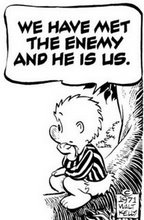 "JUST HITTING ANOTHER
"JUST HITTING ANOTHER
BRICK WALL"
The Following was found on the Drudge Report:
It is just another attempt to destroy the Church of
Jesus Christ.
Jesus Family Tomb Believed Found

Feb. 25, 2007 — New scientific evidence, including DNA analysis conducted at one of the world's foremost molecular genetics laboratories, as well as studies by leading scholars, suggests a 2,000-year-old Jerusalem tomb could have once held the remains of Jesus of Nazareth and his family.
The findings also suggest that Jesus and Mary Magdalene might have produced a son named Judah.
The DNA findings, alongside statistical conclusions made about the artifacts — originally excavated in 1980 — open a potentially significant chapter in Biblical archaeological history.
A documentary presenting the evidence, "The Lost Tomb of Jesus," will premiere on the Discovery Channel on March 4 at 9 p.m. ET/PT. The documentary comes from executive producer James Cameron and director Simcha Jacobovici (Just in time to throw dirt on the Lenten and Paschal holiday)
The Talpiot Tomb
On March 28, 1980, a construction crew developing an apartment complex in Talpiot, Jerusalem, uncovered a tomb, which archaeologists from the Israeli Antiquities Authority excavated shortly thereafter. Archaeologist Shimon Gibson surveyed the site and drew a layout plan. Scholar L.Y. Rahmani later published "A Catalogue of Jewish Ossuaries" that described 10 ossuaries, or limestone bone boxes, found in the tomb.
Scholars know that from 30 B.C. to 70 A.D., many people in Jerusalem would first wrap bodies in shrouds after death. The bodies were then placed in carved rock tombs, where they decomposed for a year before the bones were placed in an ossuary.
Five of the 10 discovered boxes in the Talpiot tomb were inscribed with names believed to be associated with key figures in the New Testament: Jesus, Mary, Matthew, Joseph and Mary Magdalene. A sixth inscription, written in Aramaic, translates to "Judah Son of Jesus."
"Such tombs are very typical for that region," Aaron Brody, associate professor of Bible and archaeology at the Pacific School of Religion and director of California's Bade Museum told Discovery News.
Ossuary Inscriptions
At least four leading epigraphers have corroborated the ossuary inscriptions for the documentary, according to the Discovery Channel.
Frank Moore Cross, a professor emeritus in the Department of Near Eastern Languages and Civilizations at Harvard University, told Discovery News, "The inscriptions are from the Herodian Period (which occurred from around 1 B.C. to 1 A.D.). The use of limestone ossuaries and the varied script styles are characteristic of that time."
Jodi Magness, associate department chair of religious studies at the University of North Carolina at Chapel Hill, told Discovery News that, based on the New Testament writings, "Jesus likely lived during the first century A.D."
In addition to the "Judah son of Jesus" inscription, which is written in Aramaic on one of the ossuaries, another limestone burial box is labeled in Aramaic with "Jesus Son of Joseph." Another bears the Hebrew inscription "Maria," a Latin version of "Miriam," or, in English, "Mary." Yet another ossuary inscription, written in Hebrew, reads "Matia," the original Hebrew word for "Matthew." Only one of the inscriptions is written in Greek. It reads, "Mariamene e Mara," which can be translated as, "Mary known as the master."
Francois Bovon, professor of the history of religion at Harvard University, told Discovery News, "Mariamene, or Mariamne, probably was the actual name given to Mary Magdalene."
Bovon explained that he and a colleague discovered a fourteenth century copy in Greek of a fourth century text that contains the most complete version of the "Acts of Philip" ever found. Although not included in the Bible, the "Acts of Philip" mentions the apostles and Mariamne, sister of the apostle Philip.
"When Philip is weak, she is strong," Bovon said. "She likely was a great teacher who even inspired her own sect of followers, called Mariamnists, who existed from around the 2nd to the 3rd century."
(Just some more Gnostic and New Age Crap)
DNA Analysis
Jacobovici, director, producer and writer of "The Lost Tomb of Jesus," and his team obtained two sets of samples from the ossuaries for DNA and chemical analysis. The first set consisted of bits of matter taken from the "Jesus Son of Joseph" and "Mariamene e Mara" ossuaries. The second set consisted of patina — a chemical film encrustation on one of the limestone boxes.
The human remains were analyzed by Carney Matheson, a scientist at the Paleo-DNA Laboratory at Lakehead University in Ontario, Canada. Mitochondrial DNA examination determined the individual in the Jesus ossuary and the person in the ossuary linked to Mary Magdalene were not related.
Since tombs normally contain either blood relations or spouses, Jacobovici and his team suggest it is possible Jesus and Mary Magdalene were a couple. "Judah," whom they indicate may have been their son, could have been the "lad" described in the Gospel of John as sleeping in Jesus' lap at the Last Supper. (I have read and re-read the Gospel of John and I have never seen where it said anything about a “lad” sleeping in Jesus’ lap at the last supper. This is plain unadulterated B. S.)
Discovery has set up a special Web site, www.discovery.com/tomb, to provide related in-depth information and to allow viewers to come to their own conclusions about the entire matter.
As Academy Award-winner Cameron said in a press release, "It doesn't get bigger than this. We've done our homework; we've made the case; and now it's time for the debate to begin."
And we can all wait with bated breath to see what the next attack will be and from where.
 "JUST HITTING ANOTHER
"JUST HITTING ANOTHER































































